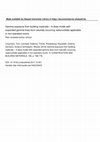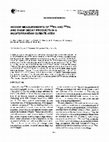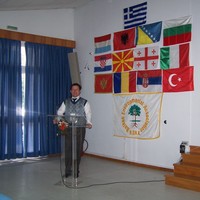Papers by Cristina Nuccetelli

Radiation Protection Dosimetry, 2004
Building materials can be an important source of exposure to gamma radiation indoors. In situatio... more Building materials can be an important source of exposure to gamma radiation indoors. In situations in which it is impossible to enter the dwellings to measure indoor gamma dose rate, as can happen in epidemiological studies and in surveys on randomly selected dwellings, it is important to obtain accurate and precise estimates of the indoor gamma dose rate. In this paper, preliminary results of a validation study of a new method, named IN-OUT, to estimate the indoor gamma dose rate attributable to the building materials are presented. This method, which is still in progress, is based on outdoor measurements, performed close to an external wall of a dwelling, and on a 'room model' elaboration, which takes into account geometrical and structural characteristics of the dwelling. The validation was performed using data--relevant to 91 dwellings, at present--collected in Latium and Campania within the framework of 'SETIL', the Italian epidemiological study on the aetiology of childhood leukaemia, lymphoma and neuroblastoma.

Construction and Building Materials
Building materials are a significant source of gamma rays exposure due to the presence of natural... more Building materials are a significant source of gamma rays exposure due to the presence of naturally occurring radionuclides. In order to protect the public from harmful radiation, the European Basic Safety Standards (Council directive 2013/59/Euratom) introduced a one-sizefits-all building(s) (materials) Activity Concentration Index (ACI) based on a limited set of gamma lines. The ACI is considered "as a conservative screening tool for identifying materials that may cause the reference level (i.e. 1 mSv/y) laid down in Article 75(1) to be exceeded". Regarding calculation of dose, many factors such as density and thickness of the building material, as well as factors relating to the type of building, and the gamma emission data need to be taking into account to ensure accurate radiation protection. In this study the implementation of an expanded set of 1845 gamma lines, related to the decay series of 238 U, 235 U and 232 Th as well as to 40 K, into the calculation method of Markkanen [1], is discussed. The expanded calculation method is called the Expanded Gamma Dose Assessment (EGDA) model. The total gamma emission intensity increased from 2.12 to 2.41 and from 2.41 to 3.04 for respectively the 238 U and 232 Th decay series. In case of 40 K a decrease from 0.107 to 0.1055 is observed. The 235 U decay series is added, having a gamma emission intensity of 3.1. In a standard concrete room, the absorbed dose rates in air (DA) per unit of activity concentration of 0.849, 0.256, 1.08, 0.0767 nGy/h per Bq/kg are observed. The use of weighted average gamma lines increased the DA with 6.5 % and 1 % for respectively the 238 U and 232 Th decay series. A decrease of 4.5 % is observed in the DA of 235 U decay series when using the weighted average gamma lines in comparison to its non-averaged variant. The sensitivity of the EGDA model for density, wall thickness, presence of windows and doors and room size is investigated. Finally, a comparison of the index and dose calculations relevant for the dose 1. Introduction Building materials are a significant source of indoor gamma dose [3]. The importance to address the exposure originating from building materials is underlined in article 75 of the Euratom basic safety standards (EU-BSS) (Council directive 2013/59/Euratom) which comes into force in February 2018 [4]. This article states that "The reference level applying to indoor external exposure to gamma radiation emitted by building materials, in addition to outdoor external exposure, shall be 1 mSv per year". This European legislation was developed to establish basic standards, applicable in EU member states, for the protection against exposure of ionising radiation for workers and the general public. In a broader context this legislation supports several launched initiatives of the European commission for turning waste into a resource and promoting re-use and recycling with focus on the building industry in the framework of the Europe 2020 strategy [5-7]. In this context the EU-BSS aims towards a safe use of by-products, originating from NORM (Naturally Occurring Radioactive Material)processing industries, like metallurgical slags, fly and bottom ash, phosphogypsum and red mud. These residues are used or investigated to use in cement-based matrixes as supplementary cementitious materials (SCM) on a large scale [8-12]. In addition more and more research is conducted to use these residues in more CO2-friendly cement alternatives, like inorganic polymers (IPs) [8-10]. This fits with the aim to reduce the usage of primary resources. It is expected that future building materials used for dwellings will shift more and more towards these secondary raw materials that can potentially be rich in naturally occurring radionuclides (NORs): therefore the impact on the external gamma exposure of the use of these secondary raw materials needs to be assessed [10,13,14]. In order to assess the impact on external gamma exposure of building materials, different calculation methods, based on Monte Carlo simulations, integration and simple index and dose formulas, have been developed in the past [1,15-26]. Different dose assessment calculations have been developed based on gamma ray attenuation and build-up factors [1,16,17,22,27]. These calculations allow specifying the physical parameters of the room and the material it is constructed out, in a straightforward way. The density and wall thickness are identified as the most critical parameters. Modifying these parameters, for the evaluation of non-standard rooms, can generate dose rate differences up to 40 % compared to a standard concrete room [27]. Seeking for a standardized approach, the EU-BSS proposes a screening index, named Activity Concentration Index (ACI) [2]. This index was originally developed by Markkanen [1] and is described in the technical guide Radiation Protection (RP)-112 [28]. The ACI is based on a number of assumptions that are not all necessarily valid. The ACI assumes a concrete room (400 cm x 500 cm x 280 cm) with a density of 2350 kg/m 3 and thickness of 20 cm for all surfaces (walls, floor and ceiling). In the last years, in order to get a reliable screening tool, that will allow for a realistic discrimination of building materials, a new density and thickness corrected index I(ρd) was developed by Nuccetelli et al. [2]. The available dose assessment models focus on the standard composition of concrete, however the increased usage of residues, which have an a priori chemical compositions differing from conventional
Applied Radiation and Isotopes, 2008
In situ gamma spectroscopy was introduced to determine the outdoor gamma dose rate from soil and ... more In situ gamma spectroscopy was introduced to determine the outdoor gamma dose rate from soil and to calculate the radionuclide concentration and the relative contribution to the dose rate. This paper reviews the most common and proven applications of in situ gamma spectroscopy-together with the most recent and innovative research outcomes obtained with this technique, particularly for its use indoors. Advantages and limitations of its utilization to assess environmental radioactivity-indoors and outdoors-are also discussed.
Journal of Magnetic …, 1990
Two-dimensional 1 H images of a solid obtained by magic-angle rotating-frame echoes are presented... more Two-dimensional 1 H images of a solid obtained by magic-angle rotating-frame echoes are presented. The images have been reconstructed by processing the rotating-frame echo signals of a solid sample under the action of static and rotating field gradients. ...

Environment International, 1996
A research program on characteristics of radon exposure in dwellings in Rome was executed. The re... more A research program on characteristics of radon exposure in dwellings in Rome was executed. The results of measurements of 22% gas concentration, besides 222Rn and their decay product concentrations, are reported. These measurements were carried out in the sitting-room of six dwellings, for 2-d periods in spring 1995, under normal living conditions. The 22'kn concentration was measured at about 1 cm from the wall, using the method of delayed coincidences between 22%n and 216Po decays. The average value in the dwellings ranged from 5 Bq/m3 to about 1100 Bq/m3. The average 222Rn and "%I equivalent equilibrium concentrations, measured in the middle of the room, were within 8-43 Bq/m3 and 0.5-9.5 Bq/m3, respectively. The average potential alpha energy concentration ratio between 220Rn and 222Rn was within 0.9-4.6. The average equilibrium factor of 222Rn ranged from 0.42 to 0.55. The estimate of effective doses is also discussed. These results confirm the significant presence of 220Rn (thoron) and its decay products and the role of certain natural building materials used in some Italian Regions, not only as gamma and 222Rn sources, but also as 220Rn sources. Copyrighf 01996 Elsevier Science Ltd S633










Uploads
Papers by Cristina Nuccetelli